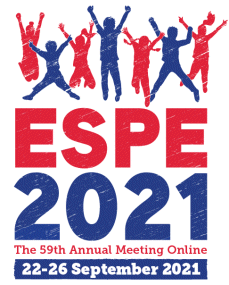
59th Annual ESPE (ESPE 2021 Online)
Online,
22 Sep 2021 - 26 Sep 2021

ePoster Category 1
Sex Endocrinology and Gonads B
hrp0094p1-141 | Sex Endocrinology and Gonads B | ESPE2021
Screening of serum differential proteins in girls with rapidly progressing central precocious puberty with TMT quantitative proteomics
Xie Rongrong , Zhang Dandan , Wu Haiying , Wang Fengyun , Chen Xiuli , Chen Ting , Sun Hui , Wang Xiaoyan , Song Mengjia , Chen Linqi
hrp0094p1-142 | Sex Endocrinology and Gonads B | ESPE2021
Investigation of primary adrenal insufficiency (PAI) in children with 46,XY differences in sex development (DSD)
Man Elim , Peters Catherine , Brain Caroline , Lichtarowicz-Krynska Ewa , Bahl Shailini , Buchanan Charles , Spoudeas Helen , Aitkenhead Helen , Hindmarsh Peter , Dattani Mehul , Achermann John ,
hrp0094p1-143 | Sex Endocrinology and Gonads B | ESPE2021
Current clinical practice of prenatal dexamethasone treatment in at risk pregnancies for classic 21 hydroxylase deficiency in Europe
Nowotny Hanna F. , Neumann Uta , Tardy-Guidollet Veronique , Ahmed S. Faisal , Baronio Federico , Battelino Tadej , Bertherat Jerome , Blankenstein Oliver , Bonomi Marco , Bouvattier Claire , de la Perriere Aude Brac , Brucker Sara , Cappa Marco , Chanson Philippe , Grinten Hedi L. Claahsen van der , Colao Annamaria , Cools Martine , Davies Justin H. , Gunther Dorr Helmut , Fenske Wiebke K. , Ghigo Ezio , Gravholt Claus H. , Huebner Angela , Husebye Eystein Sverre , Igbokwe Rebecca , Juul Anders , Kiefer Florian W. , Leger Juliane , Menassa Rita , Meyer Gesine , Neocleous Vassos , Phylactou Leonidas A , Rohayem Julia , Russo Gianni , Scaroni Carla , Touraine Philippe , Unger Nicole , Vojtkova Jarmila , Yeste Diego , Lajic Svetlana , Reisch Nicole ,
hrp0094p1-144 | Sex Endocrinology and Gonads B | ESPE2021
Ovarian AMH production is transiently affected in pubertal and prepubertal girls with acute lymphoblastic leukaemia and non-Hodgkin lymphoma receiving chemotherapy: a prospective, longitudinal study.
Lopez Dacal Jimena C. , Prada Silvina , Gutierrez Marcela E. , Bedecarras Patricia , Ropelato M. Gabriela , Arcari Andrea , Ballerini M. Gabriela , Gryngarten Mirta , Soria Marcela , Moran Lorena , Ferraro Cristina , Freire Analia , Bergada Ignacio , Drelichman Guillermo , Aversa Luis , Rey Rodolfo A. , Grinspon Romina P. ,
hrp0094p1-145 | Sex Endocrinology and Gonads B | ESPE2021
Serum anti-Müllerian hormone as a marker of ovarian reserve among childhood cancer survivors
Molinari Silvia , Parissone Francesca , Evasi Veronica , Marco Santo Di , Biondi Andrea , Cattoni Alessandro ,
hrp0094p1-146 | Sex Endocrinology and Gonads B | ESPE2021
Reaching a definitive diagnosis of hypogonadotropic hypogonadism – experience of a multidisciplinary diagnostic service
Patjamontri Supitcha , Alimussina Malika , Diver Louise A , McMillan Martin , McNeilly Jane D , K Lucas-Herald Angela , Freel Marie , Jones Greg , Kernohan Andrew , Lindsay Robert , McGowan Neil , Perry Colin , Sastry Aparna , Shaikh M Guftar , Tobias Edward S , McGowan Ruth , Ahmed S Faisal ,
hrp0094p1-147 | Sex Endocrinology and Gonads B | ESPE2021
A pre-analytical challenge to determine estradiol in children: A monovette systematically causing increased estradiol-concentrations in LC-MS/MS analysis
Lamprecht Tabea , Kleber Michaela , Rothermel Juliane , Holterhus Paul-Martin , Kulle Alexandra ,
hrp0094p1-148 | Sex Endocrinology and Gonads B | ESPE2021
Central precocious puberty and sleep patterns in COVID-19 outbreak
Umano Giuseppina Rosaria , Maddaluno Ivan , Riccio Simona , Lanzaro Francesca , Antignani Rachele , Festa Adalgisa , Luongo Caterina , Giudice Emanuele Miraglia Del , Grandone Anna ,
hrp0094p1-149 | Sex Endocrinology and Gonads B | ESPE2021
Query By Telarquia: Has there been an increase due to the SARS-COV19 pandemic?
Vilella Leyre Aurora , Martin Amaia San , Maeso Sandra , Sarasua-Miranda Ainhoa , Diez-Lopez Ignacio ,
hrp0094p1-150 | Sex Endocrinology and Gonads B | ESPE2021
Androgen insensitivity without an androgen receptor mutation: results from a large cohort study
Hornig Nadine , Kulle Alexandra , Dombrowsky Gregor , Ammerpohl Ole , Caliebe Almuth , Schweikert Hans-Udo , Audi Laura , Cools Martin , Hannema Sabine , Stuart Annemarie Verrijn , Werner Ralf , Hiort Olaf , Holterhus Paul-Martin ,



